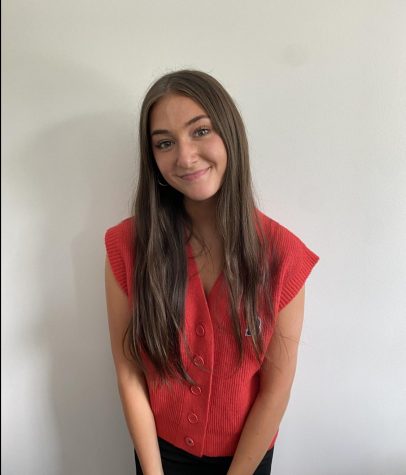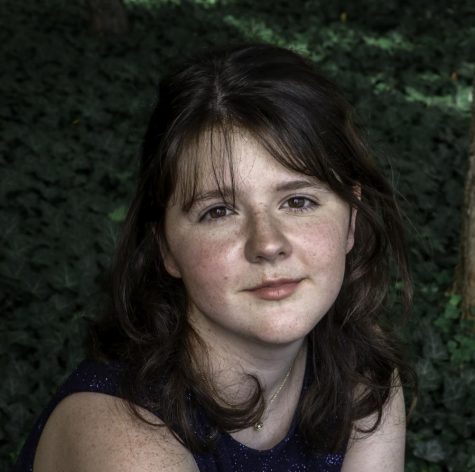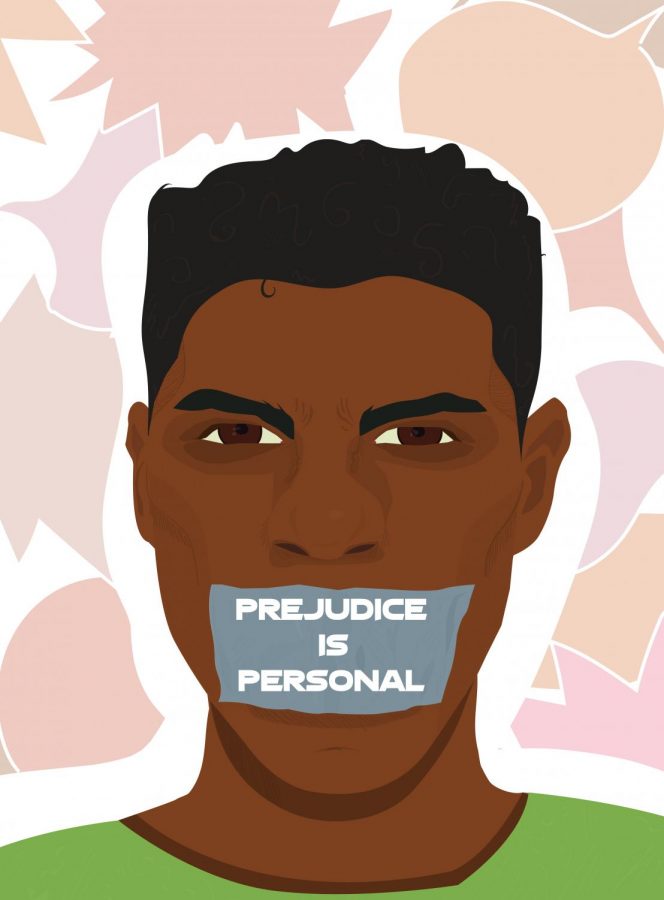Blue Valley Bigotry
A Blue Valley Movement Begins
After the recent reviving of the Black Lives Matter movement, the Blue Valley School District posted a message on Instagram, stating “racism or discrimination of any kind has no place in Blue Valley and will not be tolerated.”
The post sparked more than 1,000 comments of former and current Blue Valley teachers, parents and students, exclaiming the prejudice the school district has allowed. The following are students’ experiences with racism and teachers’ thoughts on ignorance in the classroom.
Kevin Leach
In third grade at Stanley Elementary while working on a history assignment about slavery, junior Kevin Leach experienced racism for the first time.
“[My partner] didn’t like how I wasn’t following ‘his’ instructions,” Leach said. “He said ‘God, why can’t you just listen to me? If it wasn’t for Abraham Lincoln you’d be my slave, and I would’ve whipped you already.”
Being so young, Leach was surprised and confused by the remark.
“I looked back at him in shock,” Leach said. “I genuinely didn’t know what to think about it because I didn’t know what it meant at the time.”
After a teacher overheard, the other student was sent to the principal’s office. When Leach came home from school, he mentioned the incident to his mom.
“I have never seen her walk out of the house with such anger,” Leach said. “I looked out of the window and saw steam coming from her head.”
As he grew older, that encounter became more vividly important to Leach.
“Being 16 now, I understand it,” Leach said. “That incident opened my eyes.”
Another racist encounter occurred the day after president Donald Trump was elected president in 2016. Leach was in seventh grade and walking to class with one of his friends, when they heard two teachers talking about the president’s victory. In response to one teacher’s mention of the election results, the other replied with “It’s a good thing I’m white.”
“He just gave me this look like he didn’t know we were there — he didn’t even apologize,” Leach said. “Back then I barely knew anything about politics, but it was enough to know what he meant by that.”
Leach spent a lot of time ruminating over the comment made that day.
“When I went home, I constantly thought about it for the rest of the night to the point where I couldn’t sleep,” Leach said. “I was too young to understand what happened, and it broke me down.”
Now that he’s older and more mature, Leach tries to maintain a positive outlook.
“When I experience that sort of stuff now, I use it as motivation,” Leach said. “It drives me forward and keeps me going.”
Leach advises other people who have dealt or continue to deal with racism to reach out and talk to someone they trust.
“It’s helped me grow mentally and teaches me how racism is still very present,” Leach said.
In his opinion, the district hasn’t done it’s part to combat racism, yet they are making progress. One of the biggest issues, Leach believes, is the way Blue Valley approaches Black History Month.
“Most young kids in elementary and middle school only know about Martin Luther King Jr., Malcolm X, Jackie Robinson, Rosa Parks and Harriet Tubman,” Leach said. “All of these people shaped our history incredibly, but there are so many more who did the same and don’t get recognized as much.”
Leach suggests the district teach students about the less famous figures in the civil rights movement and supplement the learning with more resources.
“Teach them about how Lynden B. Johnson, the 36th President of the United States, gave African Americans their civil rights, [and] how he helped so many poor families, black or white, to rise above the poverty line,” Leach said. “They should bring guest speakers so everyone can learn about our history.”
Leach hopes treatment of minorities will change for the better in the future.
“One day, I do hope it’s all gone, that we can start judging each other off our character instead of bringing race into it,” Leach said. “Go out and learn about other races and cultures. Who knows, you might find something interesting.”
Ethnic Makeup of Blue Valley School District
-white (70.41%)
-asain (14.45%)
-hispanic (6.38%)
-multi-racial (5%)
-african-american Black (3.44%)
-american indian/alaskan native american (0.28%)
-hawaiian/pacific islander (0.04%)
*information courtesy of the Blue Valley School District Website
Ariana Siddique
For junior Ariana Siddique, microaggressions related to her race and ethnicity have persisted since she was in elementary school.
“After vacations everyone would be like ‘Oh my God! I’m finally darker than you,’ which was just awkward,” Siddique said.
Ignorance about Siddique’s cultural identity led to remarks regarding Indian culture despite her nationality being Bengali.
“People asking me ‘Why don’t you smell like curry if you’re Indian?’ is weird,” Siddique said.
When she was younger, Siddique would be told to eat pork because “no one would know,” despite it being against the Islamic Law, the rules of her Muslim religion.
“There’s a difference between asking for a reason and pressuring someone into caving because whatever they’re abstaining from is ‘normal’,” Siddique said. “It makes me feel like a drag since I’m not eating the food they’re eating, and I have to ask before ordering. There’s always people who are slightly annoyed.”
Siddique receives questions based on stereotypes and will even receive backhanded compliments based on her ethnic background.
“There’s some lighthearted stuff that isn’t necessarily a compliment like ‘You’re pretty for a brown girl,’” Siddique said.
Peers also have unrealistic expectations of Siddique due to her race.
“Just because there are many successful Asians, everyone expects us to get straight As and become doctors or engineers,” Siddique said. “In class, a few people assume I know what I’m doing because I’m brown, and apparently that means I’m smart.”
Despite the normalcy of these microaggressions, they still hold a significant impact on Siddique.
“I usually just shrug it off, but it makes me uncomfortable— it ruins any [desire] to talk to the person,” Siddique said. “It seems like they don’t care about me as a person.”
Siddique believes the current Black Lives Matter Movement will spark change in the community.
“I think it [will] raise awareness in BV since there’s so much casual racism,” Siddique said. “BLM is really important because it [raises awareness for a] serious issue that’s been around for a while. It’s time for reform.”
Ubaid Malek
Senior Ubaid Malek began experiencing racism in middle school, and it has followed him ever since, whether it be from his classmates or a teacher.
“Being a minority in America, it is almost impossible to avoid any sort of racism,” Malek said.
He faces racism inside and outside of class and cannot escape it. Even a beeping from a computer provokes his classmates to ask if he has a bomb on him.
“Being brown-skinned and Muslim, I would always get called a terrorist, [asked] if I was related to Bin Ladin and [told] the typical ‘curry’ joke,” Malek said.
Those are only a few of the racist comments that Malek continues to receive. After Trump was elected, Malek was told by his classmates that he would get deported and needed to ‘go back to his country.’
“These comments weren’t from random people, but classmates I have gone to school with for a long time,” Malek said. “[They] use slurs to make fun of me and defend it by saying they are only joking.”
The worst experience Malek has had was in middle school when a teacher was showing a CNN news video.
“The news was about terrorist attacks and my classmates proceeded to ask me if I was related to the terrorist and said ‘look it’s Ubaid’s uncle’,” Malek said. “The teacher was there in class but didn’t do anything about the comments I was getting.”
Malek then told his parents and reported the issue to the administration, but nothing ever happened. The teacher continued to show CNN news about terrorist attacks and other sensitive topics.
With the school’s lack of help, Malek had to figure out how to deal with the racism on his own.
“I just ignored the comments, and now they just go over my head like it’s normal,” Malek said.
Although it may feel typical for Malek, the racism and bullying got so bad that he wanted to transfer schools to escape it.
“All these hurtful comments were degrading and made me feel like I didn’t belong,” Malek said. “It made me feel [as if] American culture was the law of the land, and my culture and customs were not welcome and inferior to others.”
While the school district holds one diversity assembly a year in order to celebrate other cultures, Malek said most students simply mock or laugh at it. He believes it is difficult to learn and appreciate other customs in that one short hour each year.
“The racism and unawareness of other cultures shown by classmates show how the district was failing to educate the students,” Malek said. “The district needs to do a better job at teaching about other cultures and their histories. This needs to start at a younger age so these kids become more open-minded towards other minorities and cultures.”
Because the majority of Blue Valley’s teachers are white, Malek believes the district could benefit from having more teachers and staff with different backgrounds, as well as teaching about other cultures’ history.
“It seems like the only history I learn in school is European and American history — it’s very Eurocentric, showing how Americans are the best,” Malek said. “There needs to be more history of other races and how they came to America since Europeans weren’t the only ones who settled here and built it.”
Although there are many obstacles that need to be overcome for racism, Malek is optimistic that the recent movement will help bring awareness to this issue.
“I believe the recent Black Lives Matter movement and protests will bring more attention to the problems in the district,” Malek said. “But it is up to the people in charge to take this seriously and make changes.”
- 59.6% of hate crimes are based on race/ethnicity/ancestry/bias
* from 2018 United States Justice Department data
- Black girls are suspended at higher rates than all other girls and most boys
Black and Latino students accounted for 40 percent of enrollment at schools with gifted programs, but only represented 26 percent of students in such programs.
* from the US Department of Education’s Office for Civil Rights
Do Blue Valley students think the school does a good job of educating their students about diversity?
60.6% said no
39.4% said yes
*193 students surveyed
Have blue valley students experienced racism?
30.6% said yes
69.4% said no
*193 students surveyed
Ann Vasa
As a half-Indian half-Filipino child of two immigrants, senior Ann Vasa was acutely aware of the injustices that minorities face in America. However, she was not cognizant of the amount of discrimination that is prevalent in the Blue Valley school district until nationwide demands for racial justice began in June.
“I began to realize that a lot of the things I had experienced since elementary school had to deal with matters of race,” Vasa said. “Those issues often stemmed from BV not fully educating its students on diversity, equity and inclusion,”
Vasa said she faced being criticized for the food that she packed for lunch at an early age and was often confused with the only other Indian girl in her class in elementary school.
“When I reflected this summer on my years in school, I recognized it was those small moments of injustice that hurt the most,” Vasa said. “[They] ultimately culminated into the larger-scale racial issues within the district.”
In order to avoid this repetition of microaggressions Vasa herself experienced, she recommends Blue Valley begins teaching equity in elementary school.
“I think as high school students, we often find ourselves answering bigger questions than we ever have before and can find it overwhelming to talk about racial issues,” Vasa said. “I feel if we started these conversations in kindergarten, we would be a lot more comfortable talking about issues often seen as controversial.”
In addition, she considers it vital for this education to include other sensitive topics.
“We should simply normalize having conversations about how to be respectful to marginalized groups, including students of color, LGBTQ+ students and more,” Vasa said. “No one wants to be mistreated because of their identity, so it’s absolutely imperative that we begin normalizing these seemingly uncomfortable discussions.”
When Vasa viewed the Instagram post released by the district concerning the intolerance to discrimination, she noted the message appeared to be disingenuous given the history of unjust behavior students of color have faced in the district.
“For the district to say that it has been a leader in fighting racial injustice really brought out the pain and anger that students of color had held in for so long,” Vasa said.
After reading the countless student experiences with racism, prejudice and xenophobia in their learning environment, she felt inspired to share them on an Instagram account dedicated to this cause, titled “@wethez”.
“My [Instagram] account is still pretty small with only about 150 followers, but I think it’s already starting to make a difference by highlighting the struggles that BV students have faced — struggles that their peers may not even have realized that their friends of color have faced,” Vasa said.
In early August, superintendent Dr. Tonya Merrigan created the Blue Valley Board of Education Diversity, Equity and Inclusion Committee. The committee is made up of parents, staff and administrators, as well as a student representative from each high school, and Vasa was chosen to represent Blue Valley High because of her history of being outspoken on these issues.
“I got involved with the committee after attending two of the district-wide meetings that Dr. Merrigan set up to talk about racial injustice in the district with students and parents,” Vasa said. “I’m really excited for the future of the committee and the new changes that will be made to create a more inclusive education for all students.”
Vasa advised other young people wanting to fight for progress to begin on a smaller scale by speaking to their family members or friends who may be ignorant about the topic.
“Speaking to the people who are closest to you is one of the more intimidating aspects of fighting for racial justice,” Vasa said. “You don’t want to get in an argument with those that are closest to you, but you also want them to understand these really complex issues that are harmful to people of color.”
Vasa believes that from these conversations as a whole, America can evolve past these racial disparities.
“While creating structural change is important, the only way we can really achieve that is making people understand why we need structural change,” Vasa said. “It’s imperative to create this understanding with the people that you surround yourself with, because oftentimes, you are the one that they will listen to most.”
Teachers’ Perspective
Though biology teacher Darcie Badger has witnessed racism in the classroom, she believes that most racist remarks are accidental.
“Many times I feel the individual does not even realize the hurt they are inflicting when they make [racist and biased remarks],” Badger said. “It definitely hurts my heart and saddens me, but I do try to confront those comments and make it a learning experience for the individual.”
Chemistry teacher Neerav Shah has also seen prejudice behavior in school, such as when a student of color was teased with a racially charged joke.
“It was disgusting and completely inappropriate,” Shah said.
For Badger, there are four steps the BV community should take in order to reduce racism.
“The first step would be for everyone to recognize and confront their own biases,” Badger said. “The next step would be to listen to others with an open heart and ears. [The] third step [is] be contemplative about what you hear. [The] last step [is to] take action in a way that positively improves the community and helps to eliminate racism.”
Shah notes teachers could celebrate diversity in the classroom as part of the curriculum.
“For example, in science, I [could] ask students to research a scientist of ethnic background that was influential in shaping what chemistry looks like today,” Shah said.
Badger believes the ability to spread information widely and quickly has improved measures against racism.
“Social media has brought about more awareness and recognition that racism is a problem compared to when I was a student,” Badger said.
In order to combat racism within schools, Shah said the best way is to educate students and appreciate differences.
“We need to make students more aware of the stigmas and ugliness of racism and teach them ways to alleviate the backward thinking we so often see in the BV community,” Shah said.
Similar to Shah, Badger believes empathy is key to inspiring progress.
“Have the emotional capacity to put yourself in other people’s shoes and realize the obstacles and challenges that others have, or will, face,” Badger said. “It’s important to be kind, listen with an open heart and do your best every day to be better and be the change.”

Charlie Trent is editor-in-chief and is a senior. It is her fourth year on staff. In school, she is involved in Chambers singers as Dance Captain and Choir...

Claire Powell is a senior and is this year’s editor-in-chief. This is her third year on staff and according to her mom, she is a silly person. Though...

Stephanie Kontopanos is a senior and the assistant editor of The Tiger Print. This is her third year on staff and her second year being the Newspaper Grandma...

Tymber Moody is a senior, and this is her third year on the newspaper staff. She is also this year’s web editor. Tymber is currently a tumbling...




